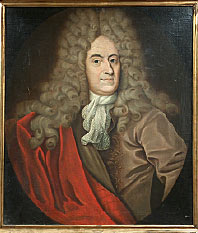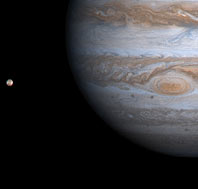
E is the vast domain of energies, and m is the
material stuff of the universe. But c is simply the speed of
light. (Celeritas is Latin for "swiftness.") How can this
particular speed—what might seem an arbitrary
number—control the link between all the mass and all the
energy in the universe?
Before Einstein could have possibly thought of using c,
someone had to confirm that light travels at a finite speed. Galileo
was the first person to clearly conceive of measuring the speed of
light. It took a brash young Danish astronomer named Ole Roemer,
however, to accomplish the feat. He did it through one of the
tensest scientific showdowns of the 17th century.
Ole Roemer's great challenge
In 1671, when Roemer was just 21 years old, he was recruited from
Denmark to work at the new Paris Observatory headed by
Jean-Dominique Cassini. Others might have been humbled to meet the
great Cassini, a world authority on the planet Jupiter and
especially on the orbits of its satellites. But Roemer was cockily
proud, enough to challenge Cassini and try making his own name.
Cassini had a problem with the innermost moon of Jupiter, the one
called Io. It was supposed to orbit its planet every 42 and a half
hours. But it never stuck honestly to schedule. Everyone—even
Cassini—assumed that the problem was in how Io traveled.
Possibly it was ungainly and wobbled during its orbit. Young Roemer,
though, reversed the problem. The question wasn't how Io was moving.
It was how Earth was moving in relationship to Jupiter.
Cassini and almost everyone of the day assumed that light traveled
as an instantaneous flash, but Roemer supposed that light took some
time to travel the great distance from Jupiter. In the summer, if
Earth was closer to Jupiter, the light's journey would be shorter,
and Io's image would arrive sooner. In the winter, though, if Earth
had swung around to the other side of the solar system, it would
take a lot longer for Io's signal to reach us.
The day of reckoning
By the late summer of 1676, Roemer had an exact figure for how many
extra minutes light took to fly that extra distance when Earth was
far from Jupiter. At the public forum of a journal all serious
astronomers read, he proclaimed a challenge: Io would appear from
behind Jupiter the following November 9 not at 5:27 p.m., as Cassini
calculated, but ten minutes later, at 5:37.
On November 9, observatories in France and across Europe had their
telescopes ready. 5:27 p.m. arrived. No Io. 5:30 arrrived. Still no
Io. 5:35 p.m. And then it appeared, at 5:37 and 49 seconds exactly.
And yet Cassini declared he had not been proven wrong! It was so far
away, so hard to see exactly, that perhaps those clouds from
Jupiter's upper atmosphere were producing a distorting haze.
Roemer had performed an impeccable experiment, with a clear
prediction, yet Europe's astronomers still did not accept that light
traveled at a finite speed. Cassini's supporters won: the official
line remained that the speed of light was just a mystical,
unmeasureable figure.
Roemer gave up and went back to Denmark. Only 50 years later did
further experiments convince astronomers that he had been right. The
value Roemer had estimated for light's speed was close to the actual
speed of light, which is about 670,000,000 mph.
It's fast, but what is it?
While the speed of light was pinpointed in the 1600s, the exact
nature of light was poorly understood until centuries later. The
story picks up in the late 1850s, when an elderly Michael Faraday
began to correspond with James Clerk Maxwell, a slender Scot still
in his 20s.
Back in his 1821 breakthrough, and then in much research after,
Faraday had shown ways in which electricity can be turned into
magnetism, and vice versa. Maxwell, who probably had the finest
mathematical mind of any 19th-century theoretical physicist,
extended the idea.
What was happening inside a light beam, Maxwell began to see, was
just another variation of this back-and-forth movement. When a light
beam starts going forward, one can think of a little bit of
electricity being produced, and then as the electricity moves
forward it powers up a little bit of magnetism, and as that
magnetism moves on, it powers up yet another surge of electricity,
and so on like a braided whip snapping forward.
Faraday's much maligned hunch that light was an electromagnetic
phenomenon had been correct after all.
|


|
While shown here as a proud middle-aged man, Roemer was
in his mid-20s when he pitted himself against one of the
most powerful astronomers of the era.

|
|

|
Giovanni Cassini became known as Jean-Dominique Cassini
when he reigned at the Paris Observatory.

|
|

|
While Io and Jupiter are easy to spot in NASA images
today, the view for 17th-century astronomers was much
hazier.

|
|
|

